Tapping Hooves: Small Bronze Figures of Dance-loving Pan
The goat-god Pan is one of the lesser gods of the Greek pantheon, but representations of him in ancient art are numerous and varied.1 This paper discusses only one type, a group of small bronze figures of the god dancing. I offer it to Eugene Lane in memory of many years of pleasant collaboration in acquiring works from antiquity representing other lesser, but nonetheless interesting, gods for the Museum of Art and Archaeology at the University of Missouri-Columbia.
Arcadia, the mountainous central area of the Peloponnesos of Greece, is the original home of Pan.2 There he was considered a major god. Small bronze figures of votaries, most carrying animals, and some with dedications to Pan incised on them,3 attest his worship in the region from as early as the 6th century B.C., but the cult came later to other parts of the Greek world. Soon after 490 B.C. it spread to Attica, slightly later to Boeotia in Central Greece, and then to the rest of Greece and the eastern Mediterranean.4 In Arcadia, Pan was worshipped both at rustic shrines and in cities. In Attica and elsewhere he was worshipped in caves, and in association with Hermes and the Nymphs, and other gods.5
In appearance, Pan combined animal and human features. He usually appears with shaggy legs and goat hooves, bearded, goat-like face and horns, but human torso, arms and upright stance.6 His nature as described in the literature reveals him to be lusty and aggressive.7 He brought fertility to livestock and protected herdsmen. In later times, in the Hellenistic period, he was also linked to war. From the Hellenistic period on, he was considered capable of creating panic in the enemy, and thus soldiers worshipped him. The word is erroneously thought to derive from the name Pan.8
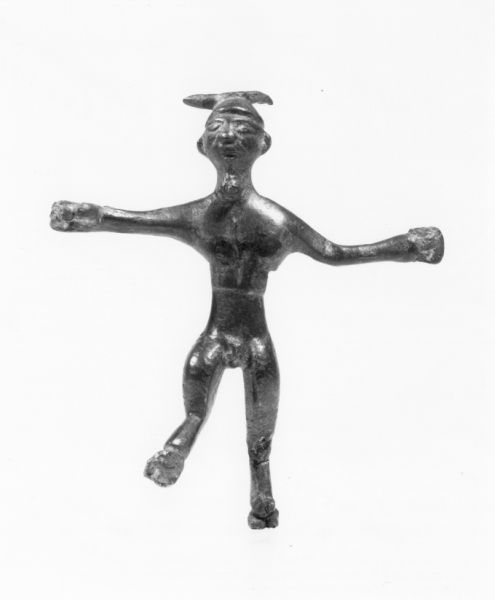
1. Pan, bronze, Museum of Art and Archaeology, University of Missouri-Columbia, 85.59,Weinberg Fund. Photo courtesy of the Museum of Art and Archaeology, University of Missouri-Columbia. Front view.
Although many ancient authors describe Pan’s worship, appearance, and nature, one set of references is of particular relevance here. They indicate the importance of dance for his cult. They describe Pan as dance-loving, as dancing with the nymphs, or as leader of the dance in heaven.9 Several small bronze figures of the god emphasize this aspect. One of these figures was purchased by the Museum of Art and Archaeology at the University of Missouri-Columbia in 1985 from a private collection (Figs. 1-3).10
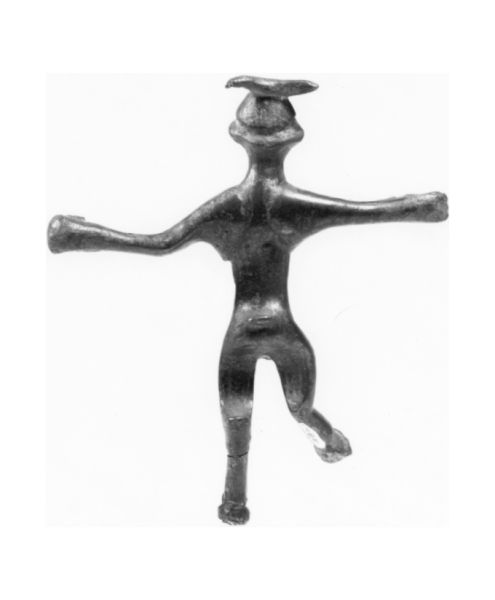
2. Missouri Pan, rear view. Photo courtesy of the Museum of Art and Archaeology, University of Missouri-Columbia
Pan dances with his right leg raised, his weight resting on his left leg. The god has both arms outstretched, his right one held straight out at shoulder height, his left one lower and slightly bent. He once held two objects, one in each hand. Both objects appear to have been round in section judging by a short, bronze plug that remains in the left hand; the curve of the god’s right hand suggests that this hand originally held a similar object. Although his torso and arms are human, his goat-like nature is immediately revealed by the lower part of his body, which resembles a goat’s hooves and hind legs; the shaggy hair on the thighs is indicated by short, semicircular incisions on the front and sides. The hair on his head forms a kind of cap from which two goat horns project to left and right. The features of the face are crudely modeled with large, irregularly placed, almond-shaped eyes, small pug nose, thick lips, and pronounced groove from nose to corners of mouth. On his receding chin is a small beard, which reaches to the base of his neck. He has small, low set, protruding ears that continue at the back of his head into a ridge below his cap-like hair. When viewed from the back or side, the most noticeable feature is the pronounced curve of the back of his thighs where a lightly incised, leaf-shaped design is evident on the smooth surface. The inner area of his legs is flat. His tail is a small stub, and the modeling of his torso is superficial with shallow grooves marking his shoulder blades, a shallow, vertical groove and a horizontal ridge on his torso at the front indicating his rib cage, and an incised circle denoting his right nipple. A very shallow scratched circle forms his belly button. The hoof on the one preserved leg is indistinctly rendered.
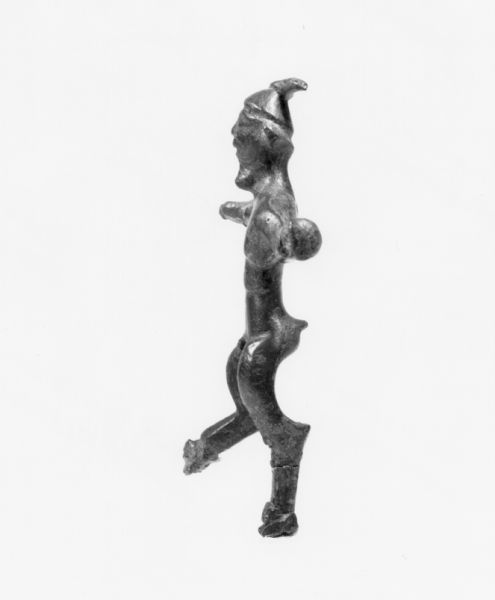
3. Missouri Pan, side view. Photo courtesy of the Museum of Art and Archaeology, University of Missouri-Columbia
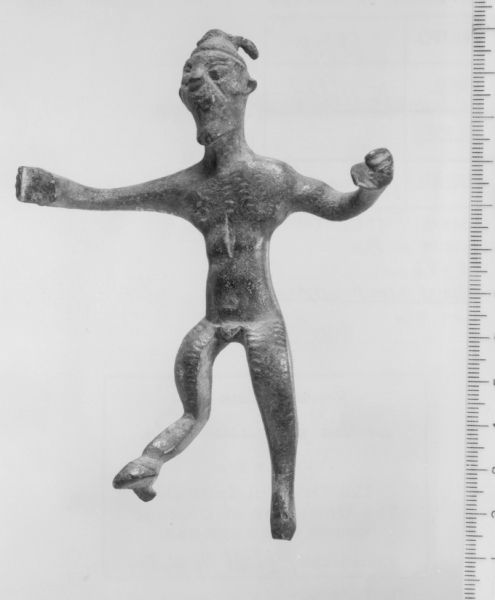
4. Pan, bronze, Oriental Institute Museum A 7448, front view. Photo courtesy of the Oriental Institute of The University of Chicago.
A number of similar, small bronze figures exist, some of which have appeared on the art market in the last decade, while others have been known for a long time. One of the latter is a Pan in the Oriental Institute Museum in Chicago (Figs.4-6).11 This figure is less worn than the one in the Museum of Art and Archaeology with incisions indicating shaggy hair preserved on the chest, as well as on the front and sides of the thighs. The inner surface and back of his legs are smooth like the Missouri Pan, but this figure does not have the lightly incised leaf-pattern of the Missouri figure on the back of the thighs. His lower left hoof is broken off, but his right leg preserves part of a strut. His left arm curves further forward than the left arm of the Missouri figure, but like the Missouri figure the objects he once held are missing. The hands do, however, preserve the cylindrical shape of whatever was once in them. The Missouri and Chicago figures appear to be of identical size, and were presumably cast from beeswax working models formed in the same master mold. They seem to be part of the same series.12
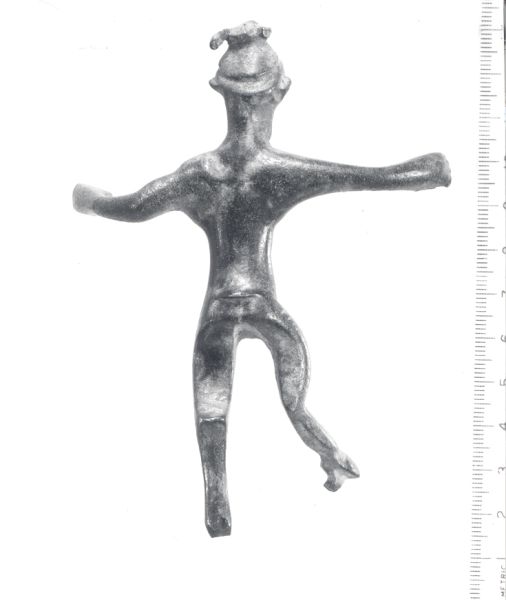
5. Oriental Institute Pan, rear view. Photo courtesy of the Oriental Institute of The University of Chicago.
A third figure of this type was once in the Schimmel Collection and is now in the Israel Museum, Jerusalem.13 It is better preserved than the two figures so far discussed and is of better quality with much more incised surface decoration, such as chest hair, pubic hair, notching on top of horns, edge of cap, contour of hair in back, eyebrows, and mustache. The beard is forked, and incised wavy lines indicate the strands of hair; its pupils are drilled. All these details are lacking in the Missouri and Oriental Institute Pans. Like the Missouri Pan, however, there is a leaf-shaped design incised on the back of the thighs. The Israel Museum Pan preserves a small, round plinth and a strut that connects the raised right hoof to it. The front and sides of the strut are notched. The position of the arms is closer to the Missouri Pan than to the Oriental Institute one; the figure is the same size as the other two. This figure was made with much greater care than the two figures discussed above. Although the same master molds may have been used, the beeswax working model was more carefully worked.
Three other figures closely resemble the first three discussed. Two were on the New York art market in 1990 and 1992 (ex Hunt and Schmidt collections); the third is now in the Bastis Collection.14 The current location of the two that were sold in New York is unknown, but the photographs published in the sale catalogues show that they are very similar to the Israel Museum Pan both in size and amount of detail. The figure from the Hunt collection is the closest and has the same height. The Pan from the Schmidt collection is slightly smaller than the Israel Museum example and appears to lean to the right, whereas the other figures are vertical. The Pan in the Bastis collection, although obviously the same type, is a much cruder version with gouged incisions for the shaggy goat hair on the thighs, disproportionately large hooves, and large protruding ears. It is about the same size as the Pan from the Schmidt collection. All these three figures preserve a plinth and a strut that connects the right hoof to the plinth.
There are thus six figures of dancing Pan, all approximately the same scale and closely resembling each other. The Israel Museum Pan, and the figures from the Hunt and Schmidt collections apparently represent one series, while the Missouri and Oriental Institute Pans, lacking the details of these three, are perhaps a separate series. The Pan in the Bastis collection stands alone. One or two further examples may also belong with these figures, but their whereabouts is unknown. Dietrich von Bothmer mentioned two that Frank Brommer had seen, one in Ankara, the other in Istanbul.15 One of these may be the figure that is now in Missouri.16
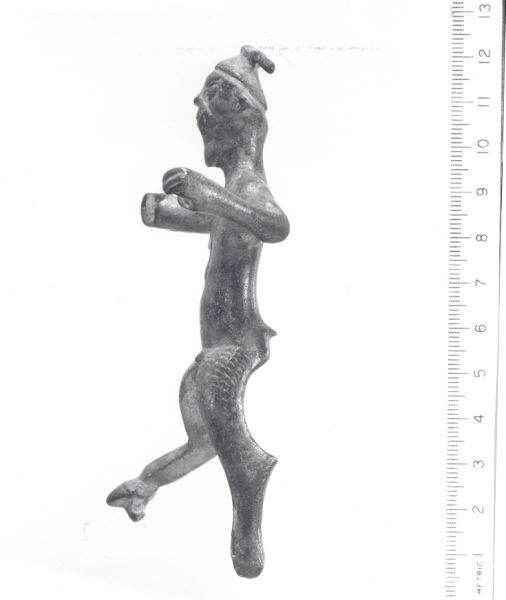
6. Oriental Institute Pan, side view. Photo courtesy of the Oriental Institute of The University of Chicago.
Four other small bronzes also show Pan dancing. One is in Lyon, the second in the Metropolitan Museum of Art, New York, and two were on the New York art market.17 The stance of all four figures is the same--right leg raised and arms stretched wide--, but in other respects they differ from the first six figures discussed. These four figures have a more sculptural treatment of the modeling of the body, and the representation of the hair on the thighs is very different. Instead of being treated as surface decoration, it forms thick rolls or folds over the front and sides of the thighs; the Metropolitan Museum Pan almost appears to be wearing a pair of breeches. On three of the figures, the Lyon Pan, the Metropolitan Museum one, and no. 4 in note 17, the surface on the backs of the thighs is smooth, because the shaggy hair on front and sides does not continue here. (The published photograph of no. 3 in note 17 shows only a front view.) This smooth area, in a sunken leaf shape, is reflected in the surface decoration on the backs of the thighs of the Missouri and Israel Museum figures. There are also differences between the four figures discussed in this paragraph. The Pan in the Metropolitan Museum is the most detailed and, unlike any of the other bronzes, wears the phorbeia, or head strap that held the double pipes in place. The Lyon Pan has realistic locks of hair that are arranged in three tiers on the back of the head, whereas the hair of the Metropolitan Museum Pan is arranged in plain, horizontal rolls. The two on the art market preserve objects in their hands, the only two figures to do so. One figure holds the Pan pipes, or syrinx, in his left hand, the normal attribute of the god.18 The other holds the pipes in his left hand and a torch in his right.19
A further example of a dancing Pan was once on the Swiss art market.20 This figure is somewhat smaller than the others and appears to have a longer torso and shorter legs, although his proportions approach those of the Lyon Pan. He is a much less detailed version than any of the others discussed above with no horns but a cylindrical object on his head.
Dates for these small bronzes are not easily established. The Lyon Pan, the figure with the earliest publication date, is assigned to the 5th to 4th centuries B.C. in the 1970 publication. Stephanie Boucher compared it to the one on the Swiss art market. This latter figure was, however, assigned a date in the 5th to 4th centuries without any parallels to securely dated works.21 Boucher also tentatively proposed a comparison with a terracotta figurine from Olympia,22 but this figurine bears no stylistic relationship to the Lyon Pan and does not appear to be a valid comparison. The Metropolitan Museum Pan is compared to the Lyon bronze and dated to the late 5th or 4th centuries B.C.;23 the Bastis Pan and the example on the New York art market in 1996 are dated by comparison with the Lyon bronze and the Metropolitan Museum one;24 the bronzes from the Hunt and Schmidt collections are compared to the Bastis, Lyon and Metropolitan Museum figures.25 The Israel Museum Pan is dated to the late 4th or 3rd century without any reasons being given.26 Thus, the dating of most of the figures of dancing Pan is based on the evidence of the Lyon Pan, which itself is not securely dated. Without parallels from excavated objects, the dates must remain problematical.
These small figures of dancing Pan must have had some function in antiquity. Dietrich von Bothmer suggested that the Israel Museum Pan might have formed a group together with the similar ones known to Brommer and perhaps were attached to the rim of a cauldron, or to another vessel, or utensil.27 Marquardt briefly discussed the function of those figures known to her. She also felt that they were originally attached to a vessel, pointing out that the hands of two of them, the Bastis Pan and the one at Sotheby’s in 1990,28 seemed to have been firmly soldered around something that made her think that the figures were on the upper part of a vessel with the hands touching the rim.29 Like Eileithyia, Pan belongs to a class of divinities who appear as multiples.30 Groups of Pans are quite common in Greek vase painting.31 Thus, a group of small bronze Pans on a bronze vessel would not seem out of place, and in the Classical and Hellenistic periods small bronze figures continued to be produced for attachment to vessel lids and shoulders.32 The smooth surface on the backs of the thighs might then be a feature of the placement of the figures on a vessel. The Israel Museum Pan, the only example that preserves its base and that is also available for examination, has, however, no marks of attachment. Furthermore single figures of dancing Pan would not be unsuitable dedications to the god since dancing was integral to his worship.33
As well as questions about their date and function, the figures raise other questions. Where were they made, what did they hold in their hands, and why was a strut thought necessary to support the right foot? Only two of the figures have any possible provenience. The Missouri Pan was acquired in Turkey; Professor Gottheil published the Oriental Institute figure as coming from Tyre, although in his correspondence with the Oriental Institute this was not mentioned.34 Other figures are described as Greek, and some are tentatively said to be Peloponnesian, although no reasons are given. As for the objects held by the figures, they may not all have held the same ones. The Metropolitan Museum Pan presumably held the double pipes, since he wears the φορβεία.35 Two of the figures hold the syrinx in their left hands. Perhaps they held the λαγώβολον in their right hands. Both objects are appropriate for Pan.36 The Missouri, Oriental Institute, and Israel Museum Pans may have held torches, one in each hand. Pan running with one torch occurs in the tondo of a black-figure kylix by the Haimon Painter Group.37 He holds two torches on a gem in Munich.38 The cylindrical impression in some of the hands, or the remains of a cylindrical object, support this suggestion, whereas the arms are perhaps too widely spread to be playing the double pipes. The presence of a strut on these small figures is puzzling. Other small bronzes of dancing figures with one leg raised have no strut, and so a strut was not necessary to support the leg.39 Perhaps the strut is a design feature that relates to the placement of the figures on a vessel.
These ten bronzes form an interesting group, linked by the dancing pose with right leg raised and arms outstretched. The treatment of the back of the thighs--smooth skin represented without hair--also links many of them. While their dates and function remain problematical, and the quality within the group varies widely, they represent a substantial body of evidence for a small-scale sculptural type of dancing Pan.
1 See K. Wernicke, “Pan (Kunstdarstellungen),” ML 3 (Leipzig 1897-1902); R. Herbig, Pan, der griechische Bocksgotte: Versuch eine Monographie (Frankfurt am Main, 1949); F. Brommer, Satyroi (Wurzburg 1937) 1-19; F. Brommer, “Pan in 5. und 4. Jahrhundert v. Chr.,” Marburger Jahrbuch für Kunstwissenschaft 15 (1949/50) 5-42; F. Brommer, R.E. Suppl. 8 (1956) cols. 949-1008, Pan; K. Schauenberg, “Pan in Unteritalien,” MDAI(R) 69 (1962) 27-42, pls. 10-17; H. Sichtermann, “Pan,” EAA 5 (1963) 920-922; Hans Walter, Pans Wiederkehr: Der Gott der griechischen Wildnis (Munich 1980); N. Marquardt, Pan in der Hellenistischen und Kaiserzeitlichen Plastik (Bonn 1995); J. Boardman in Lexicon Iconographicum Mythologiae Classicae (LIMC) (Zurich 1997) 923-941. For images of Pan in later art, see J. Boardman, The Great God Pan, the Survival of an Image (London 1998).
2 M. Jost, Sanctuaires et cultes d’Arcadie, Études Péloponnésiennes 9 (Paris 1985) 456-460; P. Borgeaud, The Cult of Pan in Ancient Greece (Chicago 1988, English translation of 1979 publication) 47-48.
3 Jost, (above, note 2) 467-468.
4 Borgeaud, (above, note 2) 48. The introduction of the cult into Attica is recorded in the well-known story in Herodotus (6.105). Before the battle of Marathon in 490 B.C. Pheidippides, sent by the Athenians to ask Sparta for help against the Persians, encountered Pan in the hills above Tegea, a city in the Peloponnesos. Pan told him to ask the Athenians why they paid him no attention. Pan goes on to say that he felt kindly toward the Athenians, had been useful to them in the past, and would be again in the future. According to Herodotus, the Athenians believed Pheidippides’ story, and once they had prospered they established a shrine to Pan under the Acropolis. At an annual festival they made sacrifices to him and ran torch races. This is the earliest mention of the god in ancient literature. See R. Garland, Introducing New Gods, The Politics of Athenian Religion (Ithaca, NY, 1992) 47-54 for discussion of the incident.
5 A shrine to Pan and the Nymphs discovered in a cave on the north slope of the Acropolis dates to the early part of the 5th century and accords well with the story in Herodotus. See Garland, (above, note 4) 59; John Travlos, A Pictorial Dictionary of Athens (Princeton 1971) 91-94, 417-421.
6 The earliest extant representation of Pan occurs on an Attic black-figure neck-amphora dated to about 490 B.C. He is shown as a goat standing beside a woman, perhaps a maenad. Only his upright stance distinguishes him as Pan (South Africa Cultural History Museum L64/4; J. Boardman and M. Pope, Greek Vases in Cape Town (Cape Town 1961) 7-8, no. 2, pl. 2; LIMC 8, 924, no. 3). On a fragment of another black-figure vase of about the same period he is playing the double pipes (Allard Pierson 2117/8; Brommer, Satyroi, (above, note 1) figs. 3, 4; Brommer, Marb. Jahrb., (above, note 1) 15, fig. 14; LIMC 8, 924, no. 4).
7 R. Parker, Athenian Religion; a History (Oxford 1996) 74-81; Borgeaud, (above, note 2) 74-87.
8 The etymology of the word Pan is uncertain. Borgeaud, (above, note 2) Appendix, 185-187, favors an etymology derived from pa(s), designating guardian of flocks.
9 E.g. Aischylos, The Persae, 449, “dance-loving Pan”; Athenaeus, XV. 694D, “O Pan, ruler over glorious Arcadia, dancing attendance on the Nymphs”; Homeric Hymn to Pan in D. L. Page, Poetae Melici Graeci (Oxford 1962) 936, “the god dances readily among the chorus of mountain nymphs”; Sophocles, Ajax, 698, “leader of the dance in heaven.” See Borgeaud, (above, note 2) 150-151.
10 Acc. no. 85.59; restored height 12.1 cm. Weinberg Fund. Bronze. Solid cast. Left leg broken off from just below the knee and restored in wood. Unpublished. Provenience: originally acquired in Turkey. Professor Saul S. Weinberg and I planned to publish a joint article on the Missouri Pan. His death in 1992 prevented this. He discovered the Oriental Institute Pan discussed below and had collected many of the other examples of figures similar to the Missouri Pan that are discussed here.
11 OIM A 7448; preserved height 11.8 cm. Purchased. Bronze. Solid cast. Left foot broken and missing. Published: Richard Gottheil, “Figurines of Syro-Hittite Art” Studies in the History of Religions, Presented to Crawford Howell Toy by Pupils, Colleagues, and Friends (New York 1912), pp. 361-365. Provenience: the Oriental Institute acquired the figure in 1931 from Professor Gottheil who had bought it in Jerusalem in about 1912. In the publication he stated that the figure was “said to have been dug up at Tyre,” (p. 361), but in the correspondence about the purchase, preserved in the archives of the Oriental Institute, he wrote that when he bought the figure he was not then told where it had been found (letter February 4, 1931, Director’s Office Correspondence Files, 1930/1931, Oriental Institute Archives. Courtesy of the Oriental Institute of the University of Chicago). I am grateful to John A. Larson of the Oriental Institute for tracking down the publication and for providing me with access to the correspondence in the archives.
12 See C. C. Mattusch, Greek Bronze Statuary: from the Beginnings through the Fifth Century (Ithaca, NY 1988) 10-30 for technology of bronze casting. For discussion of Greek serial production, C. C. Mattusch, Classical Greek Bronzes, The Art and Craft of Greek and Roman Statuary (Ithaca and London 1996) 18-21.
13 Israel Museum inv. 91.71.327, Greek. H. with plinth 13 cm. Schimmel Bequest. Bronze. Solid cast. Provenience: unknown, but said to be Peloponnesian. Published: D. von Bothmer in Ancient Art: The Norbert Schimmel Collection, ed. O.W. Muscarella (Mainz 1974) no. 25; Von Troja bis Amarna (Mainz, 1978) no. 30; News, The Israel Museum, Jerusalem, March-July, no. 2/92, illustrated on the front cover. Date: perhaps end of 4th or 3rd c. B.C.
14 (1) Greek. H. with plinth 13 cm. Bronze. Provenience: unknown (ex Hunt Collection). Published: Antiquities and Islamic Art, Sotheby’s, Nov. 28, 1990, no. 79. Date: ca. 4th c. B.C. (2) Greek. H with plinth 12.3 cm. Bronze. Provenience: unknown, but said to be Peloponnesian (?) (ex Schmidt Collection). Published: Antiquities and Islamic Works of Art, Sotheby’s, June 25, 1992, no. 84. Date: ca. 5th c. B.C. (3) Greek. H. with plinth 12.6 cm. Bronze. Provenience: unknown. Published: Antiquities from the Collection of Christos G. Bastis (Mainz 1987) no. 99. Date: 4th c. B.C.
15 Von Bothmer, (above, note 13) no. 25.
16 The late professor George Hanfmann knew the Missouri Pan, and it is possible that Professor Brommer heard about it from him. Unfortunately, Professor Brommer’s death in 1993 made it impossible to verify this.
17 (1) Lyon, Musée des Beaux-Arts, inv. L 74, Greek. H. 12 cm. Bronze. Provenience: unknown, acquired in 1850. Published: S. Boucher, Bronzes grecs, hellénistiques et étrusques (Lyon 1970) 23, no. 6. Date: 5th — 4th c. B.C. (2) New York, Metropolitan Museum of Art, inv. 1989.281.55. Greek. H. 13 cm. Bronze. Provenience: unknown but said to be Peloponnesian (gift of Norbert Schimmel Trust). Published: Von Bothmer, (above, note 13) no.25 bis and Von Troja bis Amarna (Mainz 1978) no. 31. Date: Late 5th or 4th c. B.C. (3) Greek. H. 12.7 cm. Bronze. Provenience: unknown. Published: Antiquities and Islamic Art, Sotheby’s, June 13, 1996, no. 97. Date: 5th/4th c. B.C. (4) Figure on the art market, NY. No further information available. Unpublished.
18 G. Haas, Die Syrinx in der griechischer Bildkunst (Vienna 1985) 51-52; Borgeaud, (above, note 2) 80-83.
19 The torch held by Figure no. 4, note 17, may be a restoration.
20 Greek. H. 10.3 cm. Bronze. Provenience: unknown. Published: Kunstwerke der Antike, Auktion XXII, May 13, 1961, 34, no. 61; Sotheby’s, June 11, 1977, no. 172; LIMC 8, 929, no. 105. Date: 5th/4th c. B.C. Two other figures of dancing Pan, in Swiss private collections and also from Greece, are mentioned in Kunstwerke der Antike. Marquardt, (above, note 1) 293, is surely correct to assign a modern date to a Pan with right leg raised that appeared on the art market in 1988 (Fine Antiquities, Christie’s, London, June 8, 1988, 51, no. 224).
21 Boucher, (above, note 17) 23, no. 6; Kunstwerke der Antike, Auktion XXII, May 13, 1961, 34, no. 61.
22 H. Walter, “Eine Tonstatuette des Pans,” in Bericht über die Ausgrabungen in Olympia VI (Berlin 1958) 195-199, figs. 126-127.
23 See above, note 17 (2).
24 See above, note 14 (3) and note 17 (3). Marquardt, (above, note 1) 294 agreed with a 4th century date for the four figures she discussed: the Lyon Pan, the Metropolitan Museum Pan, the Bastis Pan, and the Pan from the Hunt collection at Sotheby’s in 1990.
25 See above, note 14 (1) and (2).
26 See above, note 13.
27 Von Bothmer (above, note 13) no. 25.
28 See above, note 14 (1) and (3).
29 Marquardt, (above, note 1) 294.
30 W. Burkert, Greek Religion (Cambridge, Mass. 1985) 173.
31 For example, three Pans dance on a red-figure vase that depicts the return of Persephone from the underworld (Dresden 350 [destroyed]; ARV, 1056, 95; Brommer, Marb. Jahrb. (above, note 1) 20 and fig. 25, p. 22; pl. 16, fig. 53); two Pans dance around a goddess who rises from the earth on a skyphos in Boston (01.8032; ARV 888, 155; Brommer, Marb. Jahrb., (above, note 1) fig. 27; Cl. Bérard, Anodoi, essai sur l’imagerie des passages chthoniens [Rome 1974] pl. 12, fig. 42); several dance on the neck of a red-figure krater as a goddess rises from the earth (Berlin 3275 [destroyed]; ARV 1276; Brommer, Marb. Jahrb., (above, note 1) figs. 28 and 30; Bérard, Anodoi, pl. 16, fig. 58; and many Pans dance on a red-figure krater in London (E 467; ARV 601, 23; Brommer, Marb. Jahrb., (above, note 1) fig. 32. See also the much larger pair of bronze Pans, possibly attachments for a piece of furniture, The Gods Delight, The Human Figure in Classical Bronze (Cleveland 1988) 142-147, no. 23; Glories of the Past, Ancient Art from the Shelby White and Leon Levy Collection (New York 1990) 188-190, no. 136.
32 For discussion, see B. Barr-Sharrar, “The Private Use of Small Bronze Sculpture,” in The Fire of Hephaistos, Large Classical Bronzes from North American Collections (Cambridge, Mass. 1996) 104-121. For good examples of bronze vessels with figures attached from the first half of the 5th century, see Cl. Rolley, Greek Bronzes (London 1986) figs. 130, 131.
33 Borgeaud, (above, note 2) 150-151, and fn. 114 for references to depictions on Attic and South Italian vases where Pans are shown dancing. See note 31 above for description of some of these vases. The bronze group of four figures dancing in a circle from Petrovouni in Arcadia is now thought not to represent Pans but rather masked men. See Jost, (above, note 2) 464; Borgeaud, (above, note 2) 209, n. 64, who quotes R. Hampe, who has re-examined the group (R. Hampe, Gymnasium 72 [1965] 77-79).
34 On worship of Pan in Asia Minor, see K. Tuchelt, “Pan und Pankult in Kleinasien,” IstMitt 19-20 (1969-1970) 223-236. See note 11 above for the Oriental Institute correspondence. There was a sanctuary to Pan at Banias in the northern Gallilee. Z. Ma’oz, “Banias,” in The New Encyclopedia of Archaeological Excavation in the Holy Land, I, ed. E. Stern (New York 1993) 140-141; Z. Ma’oz, Panion I, Excavations at the Sanctuary of Pan at Banias/Caesarea Philippi (in press).
35 See above, note 17 (2).
36 See above, note 18 for Pan and the syrinx.
37 E. Simon, “Ein Nordattischer Pan,” Antike Kunst 19 (1976) 19-23.
38 Antike Gemmen in deutschen Sammlungen, Munich I, 1, no. 335.
39 See, for example, two Etruscan figures, a dancing woman (G. Richter, Furniture of the Greeks, Etruscans and Romans [London 1966] fig. 468) and a silenus in Boston (M. Comstock and C. Vermeule, Greek, Etruscan and Roman Bronzes in the Museum of Fine Arts, Boston [Boston 1971] no. 182). Also, compare a small Hadrianic bronze of a dancing child (Musée du Petit Palais, Bronzes Antiques de la Collection Dutuit [Paris 1980] no. 12).
Figures
- Figs. 1-3. Pan, bronze, Museum of Art and Archaeology, University of Missouri-Columbia, 85.59, Weinberg Fund, front, side and rear views. Photos courtesy of the Museum of Art and Archaeology, University of Missouri-Columbia.
- Figs. 4-6. Pan, bronze, Oriental Institute Museum A 7448, front, side and rear views. Photos courtesy of the Oriental Institute of The University of Chicago.